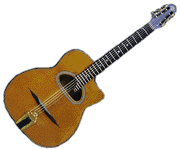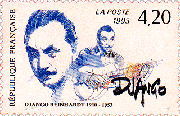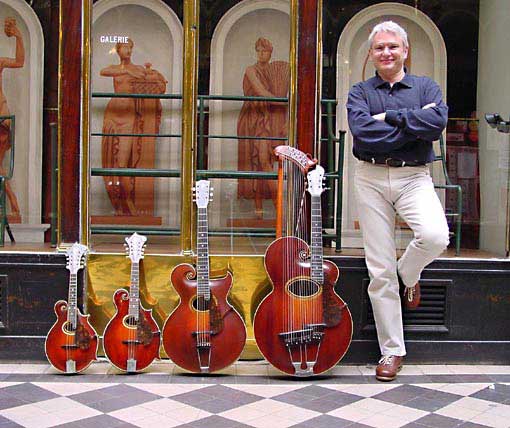
Background
information
An
introduction (start
here)
Is
it a Maccaferri?
Or
is it a Selmer?
The
Internal Resonator
About
Mario Maccaferri
in
English
in
French
Selmer
Primer
About
François Charle
The
Selmer
Maccaferri book
Manouche-Tone
Strings

the
rest of
the site
Paul
Hostetter, luthier
Back
to
the main page
Email:
click
here
|
Here is a
quick primer
on Selmer guitars
Whether you're
interested in a new Selmer-style guitar or just
curious
about the old Selmers and that family of guitars,
until you get
yourself
a copy of François Charle's wonderful book
on Selmer guitars, this will be a help in
sorting out some basic
details. A few more may be found by going through the
links at left here.
From the beginning
in
l932, Selmer
offered five basic models:
| The model "Espagnol,"
a true Spanish-style guitar having a smaller
body with a flat top, a
conventional
glued-on bridge for gut strings and a round
soundhole.
The "Concert"
model, featuring the larger standard
"Maccaferri" body design with a
flat,
fan-braced top, was offered with a larger
D-shaped soundhole, a
glued-on
bridge for tied gut strings and an optional
cutaway.
The "Jazz"
model, designed for steel strings, came with
a tailpiece, a floating
bridge
centered between two "moustaches," and a
standard cutaway. The 12-fret
model with a D-shaped soundhole was
redesigned in 1934 with 14 frets
clear
of the body and a smaller oval soundhole.
The "Hawaïenne"
model was a steel-string made for lap-style
playing, essentially a
non-cutaway
version of the "Jazz" model except for a
thicker, wider neck, a raised
nut and an optional seventh string.
Finally, the "Orchestre"
model, a less precisely defined steel-string
offered with either a
round
or D-shaped soundhole, full body or cutaway,
four or six strings.
Selmer
sold many custom variations through its
dealers and the "Orchestre"
designation
encompassed them all.
Selmer's four-string
guitars, made
mostly for
its London dealer, were built on either a
small body or on the standard
cutaway "Jazz" body. The little ones were
"ténor" guitars, with
shorter scales intended for tuning in fifths
like a tenor banjo, while
the larger ones known either as modèle
"Orchestre" or, in one
variation,
the "guitare Eddie Freeman," in honor of an
active jazz guitarist
living
in England. The Freemans were intended to
be tuned in Freeman's own
unusual reëntrant tuning. Selmer also
produced a few large-body plectrum
guitars
with a more conventional long neck, intended
for the more customary plectrum
tuning.
|
The D-hole models of 1932-33 were designed to contain
Maccaferri's patented Internal
Resonator, which comprised a sort of second wooden
soundbox
built
inside the regular body. The
"modèle
Jazz," destined to become Django Reinhardt's preferred
guitar to the
end
of his career, was introduced around the middle of
l934, after Mario
Maccaferri's
association with Selmer had ended. It had a small
vertical oval
soundhole
and somewhat different internal bracing. Almost as
importantly, it
deliberately
had no internal resonator.
On 25 September l952,
Selmer
sold its stock of wood, parts, patterns, molds,
machinery and its last
instruments to the Paris luthier, Jean Beuscher.
During the entire
existence
of the Selmer guitar atelier, less than a thousand
guitars were
manufactured.
|
|
|

François
Charle, the noted luthier,
collector and dealer in Paris, wrote and
published the definitive book on Selmer and
Maccaferri guitars. Work on this labor of
love began in earnest a decade before it
finally appeared in print in 1999. In the
process of preparing this work, he
documented hundreds of the surviving Selmer
guitars, traveling all over Europe to do
interviews and take photos. In this effort,
he enjoyed the support and cooperation of
myriad other collectors, experts, and
musicians around the world. The book was
released in 1999. Both its
French and English hardback editions sold out
quickly, but it remains available in
paperback.
Working
plans for a Selmer, anyone? Click here.
To find out more about François Charle, visit:
www.rfcharle.com
Do you own a Selmer
guitar?
François Charle is archiving a
complete database on Selmer guitars
and has over 500 in his list
already.
Please contact him about it,
if you haven't already.
All references kept
strictly confidential.
Drop me
a line click
here
This
page © 2002 - 2018 Paul Hostetter. All
rights reserved.
|
|




